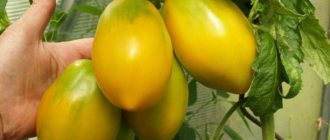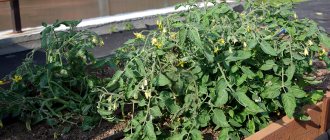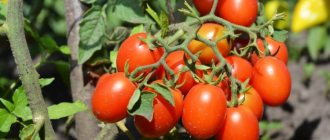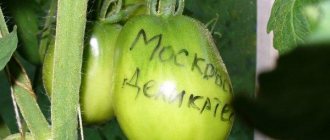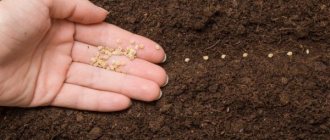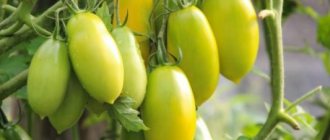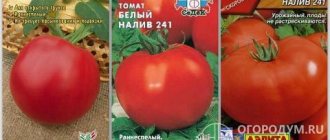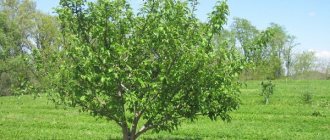| Ripening period: | mid-early (100-120 days) |
| Shape, weight of fruits: | oblong, 80-120 g. |
| Determinacy: | short |
| Regionality: | all regions of Russia |
| Productivity: | 8 kg per 1 m2 |
The Watercolor tomato has proven itself due to its early ripening, ease of care, high yields, pleasant taste and aroma. When growing a variety, the main thing is to plant it correctly, take into account all the care recommendations and enjoy the healthy vegetable.
Characteristics and description of the variety
The Watercolor variety belongs to the Siberian selection of tomatoes. Has high cold resistance.
Within 100-120 days after germination, the fruits reach technical ripeness. The crop is capable of providing a stable, high-quality harvest in any region.
Bushes up to 50 cm high form powerful, stable stems and dark green leaves. The manufacturer assures that the plants do not need to be tied to supports due to their limited growth and strong trunk. But reviews from gardeners say the opposite. Due to the abundance of fruits, gartering of tomatoes is still required.
Fruit
The Watercolor variety is valued for its cream-shaped fruits with a small roundness, which are colored a rich red color. A distinctive feature of the culture is yellow spots located near the stalk.
In the cross-section in the photo you can see two chambers with a small amount of seeds.
The weight of one fruit is from 80 to 120 g, which is very pleasing to housewives who prepare home preserves.
Taste qualities
Ripe tomatoes of the Watercolor variety consist of 6% dry matter, have juicy, dense pulp, and strong skin. Tomatoes have a pleasant sweet taste and delicate aroma.
Productivity
The average yield is 6-8 kg per square meter. The first ovary is formed when 4-5 leaves appear on one shoot. Each branch bears 6 fruits of the same size.
Usage
Thanks to their good taste and aroma, Watercolor tomatoes are consumed fresh, various dishes are prepared from them, and healthy preparations for the winter are made. Housewives are especially fond of tomato paste, since the dense structure of the vegetable makes it possible to make a high-quality product. Also, bright tomatoes, identical in color and size, look appetizing in jars. Tomatoes are suitable for preparing sauces, stews, soups, and salads.
Reviews:
I’ve been growing the “Aquarelle” tomato for several years now, and I’m very pleased with the harvest. The fruits are plum-shaped, small, have a long shelf life, and are perfect for canning. I liked the variety because it does not require special care. There is no need to tie them up or constantly cut off excess shoulder straps. Fresh and canned tomatoes are very tasty, my family is delighted with them.
I was pleasantly surprised when I harvested the first harvest of the “Aquarelle” tomato. From one square meter about 7 kilograms. Every bush was strewn with tomatoes, which made me very happy. During ripening, I sprayed the plants against late blight and that’s it. The fruits are elastic, sugary, pleasant to the taste, not sour.
The Watercolor tomato will become one of your favorite nightshades that you planted on your site. The best breeders worked on developing this variety, so it will not disappoint you!
Similar varieties
According to the characteristics and description of the variety, the Watercolor tomato is in many ways similar to such varieties of tomatoes as:
- Slivovka;
- Large cream;
- Maryushka.
Slivovka was bred by Siberian breeders. Early variety. It has a determinate type of bush up to 40 cm high. The fruits in appearance resemble Watercolor tomatoes, but are somewhat larger than the latter.
Large cream is a low-growing variety of tomatoes with a ripening period of 105-110 days. The fruits have a plum-shaped shape, as indicated by the name of the vegetable crop. The plant is resistant to late blight, verticillium and fusarium. Suitable for growing in open ground.
Maryushka is a determinate plant with a medium-early ripening period. The variety tolerates temperature changes well and is resistant to major tomato diseases. The red fruits resemble cream. The weight of one tomato is 60-70 g.
Reviews:
Galina Aleksandrovna S, pensioner:
The purchased bag contained 27 seeds of the Aquarelle variety. Before planting, I kept them in an infusion of wood ash and germinated them in a damp cloth until roots appeared. 24 germinated. I hardened them and sowed them in boxes. 22 seedlings survived to picking.
In mid-March, I planted them in individual pots. Two weeks later I fed her with Agricola. The seedlings turned out to be stocky and did not stretch out. I planted it in the garden in mid-May. She didn’t cover it with anything. I even tied up the low bushes. I was pleased with the harvest. Even without special care (there was not enough time to complete all the necessary work), the harvest collected from 21 bushes was enough for our entire large family and was left for spinning.
Tomato "Aquarelle" is a mid-early, productive, determinate tomato. Developed by Siberian breeders and recommended for cultivation in open ground and in various types of film shelters.
Growing seedlings
To get a good harvest of Watercolor tomatoes, you need to use the seedling method when growing.
Sowing work should be planned at the end of February. It is recommended to purchase planting material from trusted places and plant it in plastic containers and cups filled with nutrient substrate.
To increase seed germination, the following procedure is required:
- Cover the containers with nutritious soil enriched with mineral and organic fertilizers.
- Sow seeds into the soil to a depth of no more than 1 cm.
- Water with warm water, temperature up to 20 degrees.
Subsequently, the seedlings are watered at intervals of 10 days. It is important not to overdo it so as not to erode the soil and expose the young root system.
Intensive seed germination is possible only at a temperature of at least 23 degrees. The humidity level should not exceed 65-70%.
If all planting rules are followed, the first shoots will appear within a week.
A special plant growth stimulator will help speed up the emergence of seedlings. The drug Epin is popular among summer residents.
The period from sowing seeds to planned planting in open ground is 60-65 days.
Watercolor tomato seedlings are transplanted into beds 2 months after planting the seeds. A delay of 8 days is allowed, but no more.
How to paint a tomato in watercolor
We take a pencil in our hands and outline a circle, then we schematically designate the foliage
Step 2
Then I decided that a whole tomato is boring, so we outline the outline of half, it’s better not to press on the pencil
Step 3
We outline the outline with a black pen. I noticed that even the pros don’t take this detail into account, but in vain. Sometimes an expressive outline is half the picture
Step 4
Let's start painting with watercolors, if you have A4 paper, then it is better to do it almost dry and with a break of about 20 minutes for each layer))
Step 5
Take green and paint the greens layer by layer, go from light to dark, add shades of red, brown, orange to the tomato, as shown in the image
Step 6
This part is quite problematic, not only in the drawing, it is important to show the contrast between the two parts of the tomatoes. First layer - mark the seeds and again go from light to dark
Step 7
We gradually darken the necessary areas, in the end it is better to use brown, dark purple, if you are not afraid, then you can use black. We draw the outline with a black pen, hatching here and there
Step 8
Now is the time to take care of the background and increase the color intensity)) For the background I took blue and purple. The drawing is ready, thank you for your attention, have a nice day)
Source
Planting in the ground and care
You can plant seedlings in open ground in late April - early May. The landing site should be well lit by the sun, protected from strong winds. The most successful predecessors of tomatoes are legumes and carrots.
For successful cultivation, it is necessary to properly plant seedlings, which consists of the following steps:
- Distribute the territory according to the scheme for 1 sq. m. 4 tomato bushes.
- Dig holes no more than 20 cm deep, add mineral fertilizers to the bottom and fill with water to the very edges.
- Lower the seedling into the hole, evenly distributing the root system and sprinkle with soil.
The Watercolor tomato variety does not require special care, but for successful growth and harvest, the following agrotechnical practices should be implemented:
- Remove leaves and shoots in a timely manner. The procedure is carried out several times a season, as excess shoots appear. Also trim at least 3 lower stepsons per week. Thanks to this procedure, all nutrients will be aimed at the formation of fruits.
- Feed the plant. To accelerate growth and quickly form a crop, foliar fertilizers for tomatoes are used.
- After flowering and the formation of three inflorescences, treat the plants with a 20% bromine solution. This will accelerate the growth and formation of fruits.
- Hill up and mulch to strengthen the root system. Before hilling, the plant is watered. Hay, sawdust, pine needles, and compost are used as mulch.
- Remove weeds, loosen the beds to saturate the soil with moisture and prevent the appearance of crust.
- Water at all stages of crop development, which will allow the tomatoes to become sweet and juicy.
Knowing the needs of Watercolor tomatoes, you can subsequently enjoy the fresh taste of tomatoes and prepare this healthy vegetable for the winter.
Master class on drawing a sketch of a tomato
Every artist, even setting himself the task of painting a picture with oil paints, pastels or watercolors, first makes a sketch in pencil. Only then does he begin to design the painting in color.
This master class shows how to draw a tomato with a pencil step by step for beginners.
- It is not necessary to start sketching with a general outline. In this master class, the expert recommends applying the strokes of the lower part of the stalk to the sheet first.
- Then you should add volume to this part.
- Since it is impossible to draw a tomato without drawing the outline of the fruit itself, the next stage is drawing it. Usually it is an oval or a circle.
Diseases and pests
The tomato variety Watercolor demonstrates resistance to septoria and blossom end rot. To protect against other common diseases and dangerous pests, preventive procedures are carried out by spraying plants with complex preparations.
Failure to comply with agrotechnical standards may result in:
- Aphids, slugs, spider mites, which cause the growth of the bush to stop, the absence of inflorescences and fruits. Chemical and folk remedies are used to combat it.
- Late blight, for the treatment of which it is necessary to treat with a fungicide.
Plants must be systematically checked for disease symptoms and prompt action taken to preserve the harvest.
Advantages and disadvantages of the variety
The main advantages of the Watercolor tomato variety include:
- high yield rates;
- excellent taste and appearance characteristics;
- ease of care;
- non-susceptibility to diseases such as septoria, blossom end rot;
- the possibility of growing both in open beds and in greenhouse conditions;
- preservation of presentation during transportation;
- versatility in use (the fruits are good fresh or canned).
The only drawback, according to reviews from gardeners, is the hardness of the skin of the fruit.
The advantages of the Watercolor tomato variety significantly outweigh the disadvantages, which explains its popularity among experienced gardeners.
Compliance with the rules of agricultural technology will allow you to grow strong vegetable bushes that will delight you with a harvest of high-quality fruits.
Master class: how to draw a cross-section of a tomato with a simple pencil
Perhaps this is the most difficult stage in depicting tomato fruits.
- Start drawing with an image of an oval. Only it will imitate the cut itself, so it is located slightly above the plane on which half of the fruit will lie. And the oval itself should be very elongated and slightly inclined towards the surface.
- A semicircle is attached to the bottom of the oval - this is the lower part of the tomato.
- The oval shows the grooves in which the seeds are located.
- The lower part of the tomato is shaded more intensely than the cut itself. The rule for shading the ball should be observed: it is darker at the edges than towards the middle.
- The grooves have the most intense shading. Along the cut, you can make lines closer to the contour of the oval.
